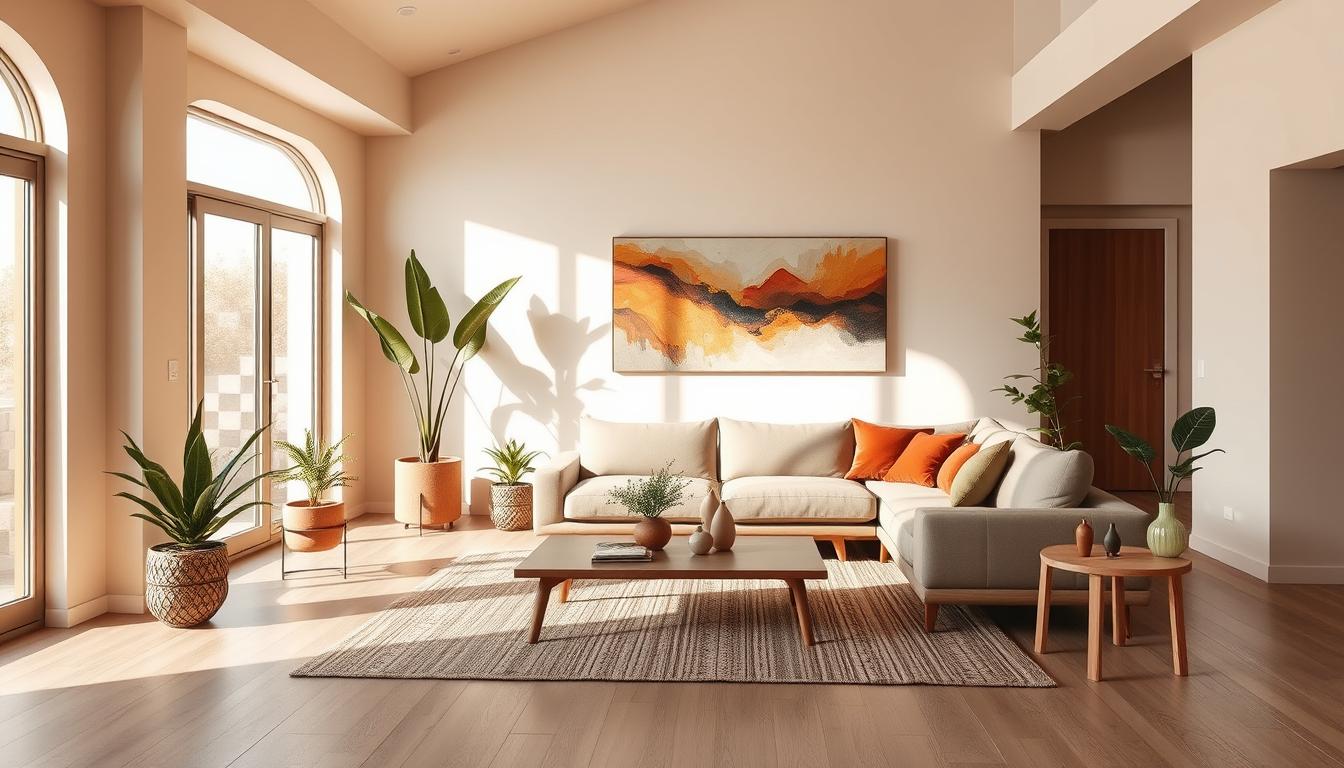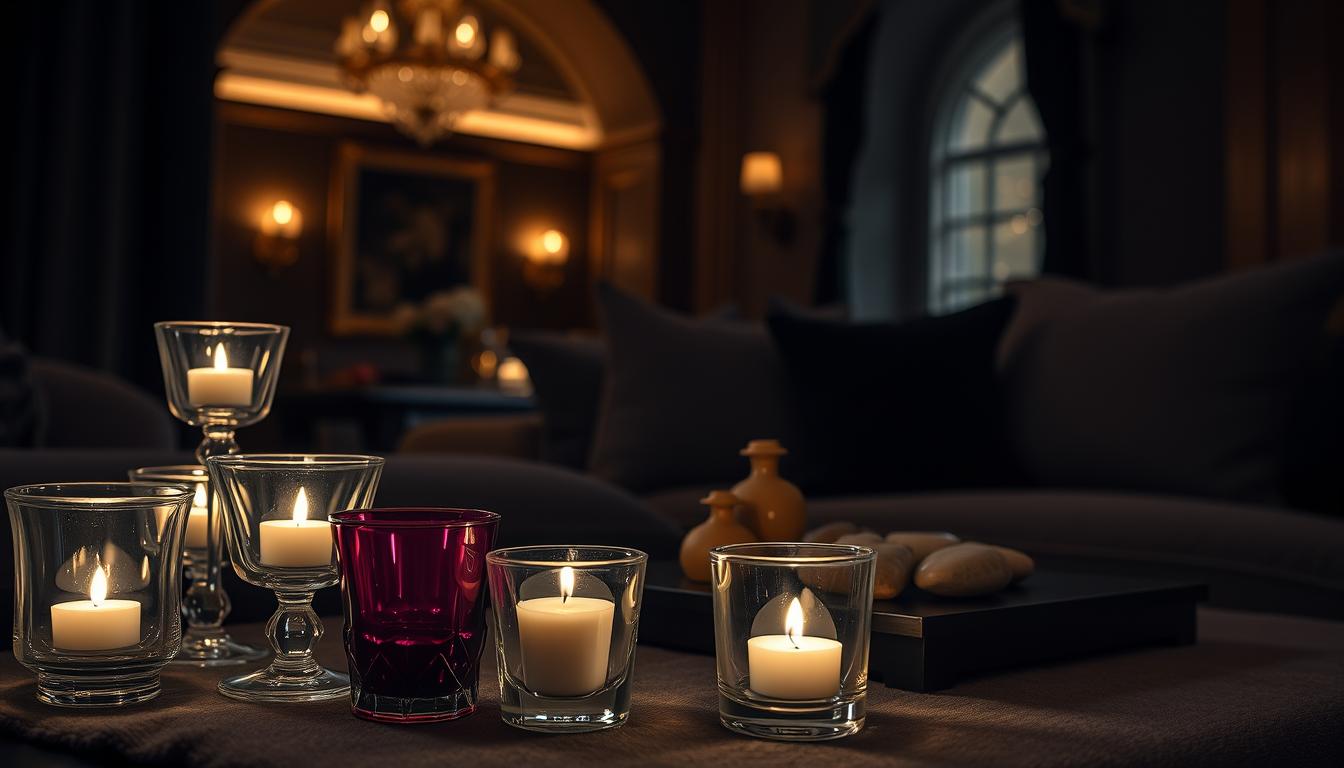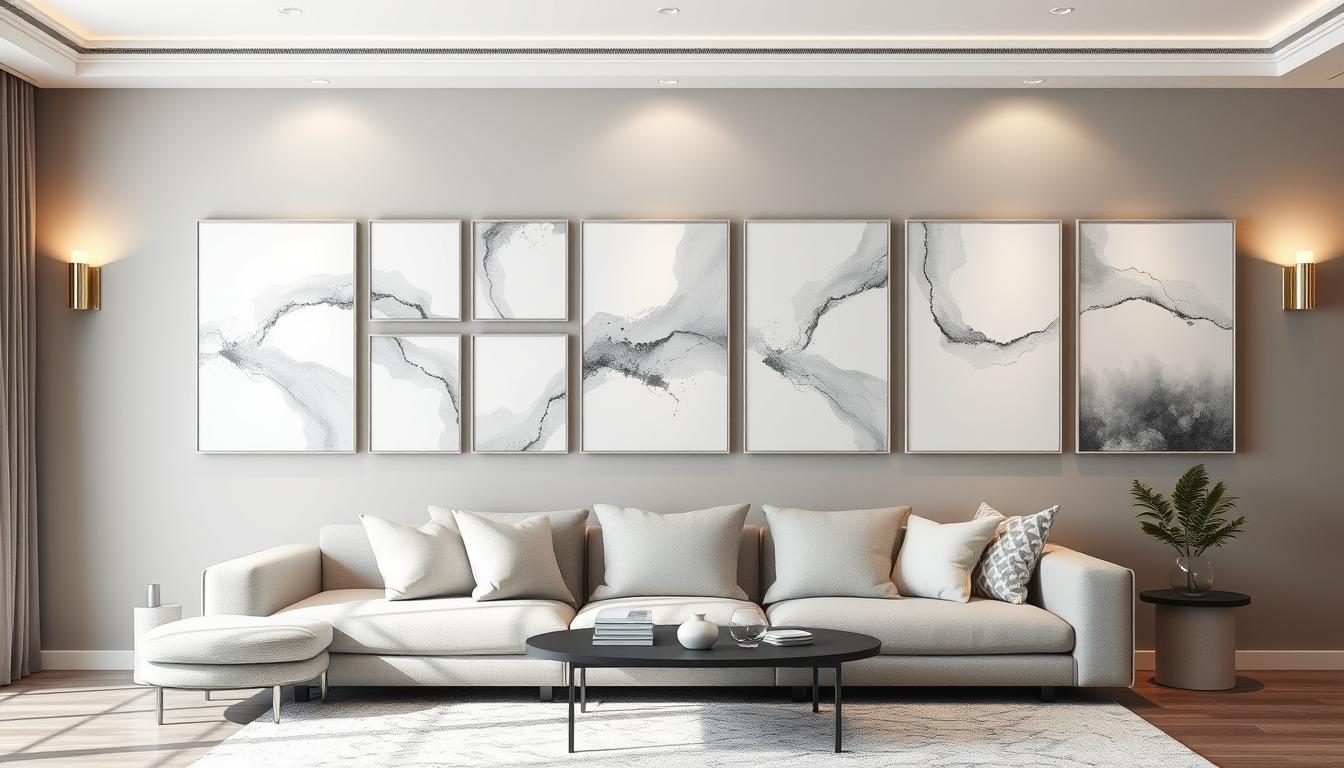As we enter 2023, our homes are changing. Vogue’s survey of 13 interior designers shows the latest trends. Now, sustainability and sanity are key in design choices.
We’re seeing big changes in our living spaces. There’s a big push for eco-friendly solutions and mindful living. This isn’t just about looks; it’s about making spaces that are both lovely and green.
Key Takeaways
- Eco-friendly materials are becoming increasingly popular.
- Mindful living spaces are being designed to promote sanity.
- Modern decor ideas are focusing on sustainability.
- There’s a growing trend towards minimalism.
- Natural elements are being incorporated into designs.
Embracing Sustainable Design Practices
As we move towards a greener future, sustainable design practices are key in home design. More people want eco-friendly homes, showing they care about the planet.
Joshua Smith, a top designer, says, “People now choose green options, and it’s about time. Sustainable design is becoming a big deal.” It’s not just about being green; it’s about making homes healthier.
Why Sustainability Matters
Sustainability is vital for our planet and health. It cuts down our carbon footprint and makes our homes better for the environment. Sustainable homes also improve air quality and reduce harmful chemicals, making them healthier for us.
Eco-Friendly Materials to Incorporate
Using eco-friendly materials is essential for sustainable design. Consider these options:
- Recycled or sustainably sourced wood
- Bamboo and cork for flooring and furniture
- Low-VOC (Volatile Organic Compound) paints
- Natural fibers like cotton, hemp, and linen for upholstery and textiles
These materials are good for the planet and make your home look unique.
Tips for a Greener Home
To make your home greener, do more than just pick the right materials. Here are some tips:
- Use natural light to cut down on artificial lighting.
- Choose energy-efficient appliances and lights.
- Start recycling and composting at home.
- Think about repurposing or upcycling furniture instead of buying new.
By following these tips, you can make your home beautiful and eco-friendly.
Bold Colors Making a Comeback
This year, bold colors are back in interior design, making spaces vibrant. As we look at 2023’s trends, bold colors are key in changing how we see our homes.
Popular Color Palettes for 2023
In 2023, we’re seeing a blend of old and new colors in our homes. Brown shades are still popular, adding warmth. Romantic mauve is also on the rise, bringing elegance.
Interior designers are now choosing silver over gold or bronze for a modern look. This move towards silver is part of a trend that mixes modern and luxury in home design.
| Color | Description | Best Used In |
|---|---|---|
| Shades of Brown | Warm, earthy tones that add coziness | Living rooms, bedrooms |
| Mauve | Elegant, sophisticated hue | Dining rooms, accent walls |
| Silver Accents | Modern, sleek metallic finish | Decorative accessories, lighting |
How to Use Color Effectively
To use bold colors well, balance and harmony are key. Pair bold walls with neutral furniture and decor. This makes a bold wall the room’s focus without feeling too much.
Another way is to use bold colors in accent pieces like throw pillows or rugs. This adds color and personality without overwhelming the room. Plus, it’s easy to change up as trends shift.
Accent Walls: A Statement Piece
Accent walls are still a favorite for adding bold colors to homes. Painting one wall in a bold color creates a focal point. It adds interest to a room.
When picking a color for an accent wall, think about the room’s colors and the mood you want. For a bold look, choose a color that stands out. For something more subtle, pick a color that complements but still stands out.
The Rise of Multi-Functional Spaces
The modern home is changing, with spaces that do more than one thing becoming popular. As we spend more time at home, we need spaces that can change with our activities.
Designing for flexibility is key in making multi-functional spaces. Choose contemporary furniture styles that can do more than one thing. For example, a coffee table with storage can be a place to socialize and store things.
Designing for Flexibility
To make spaces flexible, think about using modular furniture. This means furniture that can be moved around to fit different needs. Think about sectional sofas, nesting tables, or wall-mounted desks. The goal is to make a space that can easily change its use.
“The way we live is changing, and our homes need to adapt. Multi-functional spaces are not just a trend; they’re a necessity for modern living.”
Using technology is also important to make a space more functional. Smart home devices can control lighting, temperature, and entertainment. This makes it easier to change a space for different activities.
Essential Features for Multi-Use Areas
When making multi-use areas, some features are crucial. These include:
- Versatile furniture that can do more than one thing
- Storage solutions to keep the space tidy
- Flexible lighting that can be changed for different activities
- Technology integration for better functionality
| Feature | Description | Benefit |
|---|---|---|
| Modular Furniture | Furniture that can be rearranged or repurposed | Enhances flexibility and adaptability |
| Smart Lighting | Lighting systems that can be controlled remotely or adjusted automatically | Improves ambiance and functionality |
| Storage Solutions | Units designed to keep clutter at bay | Keeps the space organized and clutter-free |
In conclusion, multi-functional spaces are a response to changing home needs. By using flexible design, essential features, and modern furniture, we can make spaces that are both useful and beautiful.
Timeless Vintage Aesthetics
Timeless vintage aesthetics are still loved by many, offering a rich mix of design elements. They can be mixed and matched to create a unique space. This style is not just about nostalgia; it’s about creating a warm, inviting atmosphere that feels luxurious and personal.
Adding vintage elements to your home adds depth and character. Whether it’s antique furniture, vintage accessories, or retro colors, vintage aesthetics offer endless possibilities for creativity.
Integrating Retro Elements
To add retro elements to your decor, start by picking your favorite era. It could be the Art Deco of the 1920s or the mid-century modern of the 1950s and 60s. Then, look for vintage pieces that fit your style.
Mixing vintage with modern elements creates a fascinating contrast. For example, a vintage armchair with a modern sofa adds depth to your living room.
Popular Vintage Styles to Consider
Several vintage styles are popular in home decor today. These include:
- Art Deco, known for its geometric patterns and luxurious materials.
- Mid-century modern, characterized by clean lines, organic shapes, and functional simplicity.
- Bohemian, which celebrates free-spirited eclecticism and vintage treasures.
Let’s look at a comparison table to understand these styles better:
| Vintage Style | Key Features | Decorating Tips |
|---|---|---|
| Art Deco | Geometric patterns, metallic accents, luxurious fabrics | Use statement pieces like vintage lighting fixtures or decorative accessories. |
| Mid-century Modern | Clean lines, organic shapes, minimal ornamentation | Incorporate vintage furniture with modern textiles and decor. |
| Bohemian | Eclectic mix of vintage and global elements, rich textiles | Layer different patterns, textures, and colors to create a cozy, inviting atmosphere. |
By incorporating these vintage styles, we honor the past and create unique spaces. Whether you love the glamour of Art Deco or the laid-back vibe of Bohemian decor, vintage aesthetics offer endless inspiration for luxury home decorating.
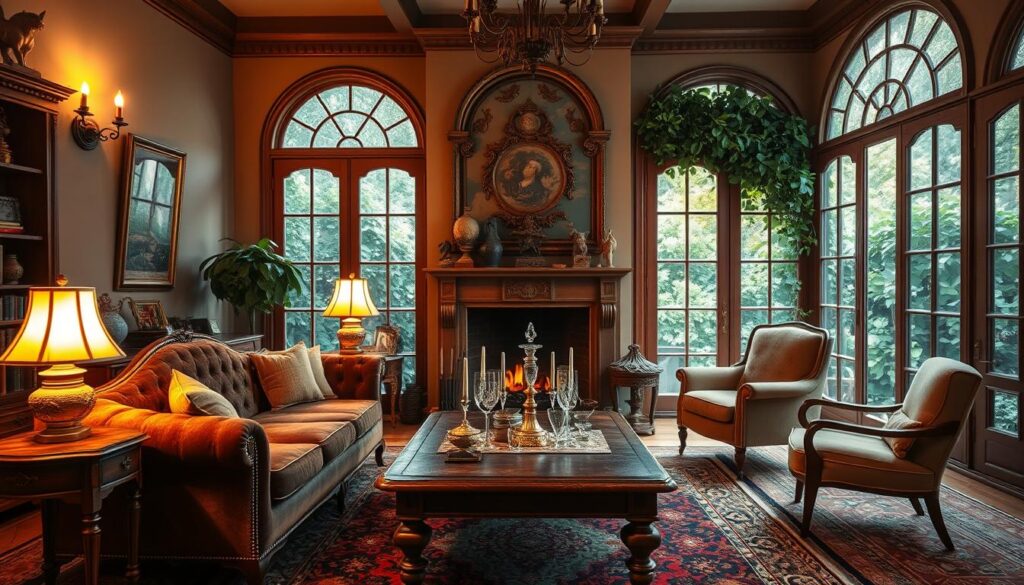
Natural Light and Open Spaces
Natural light and open spaces are leading trends in home design this year. They turn our homes into peaceful retreats. We focus on comfort and well-being, making natural light and open plans essential.
Maximizing Natural Light in Your Home
To use natural light well, think about your home’s layout and direction. Mirrors near windows reflect light into darker spots. And, keep windows clear for more sunlight.
Sheer curtains or blinds help control light and privacy. A light color scheme also makes rooms feel brighter and more open.
The Benefits of Open Floor Plans
Open floor plans are loved for their spacious feel and social benefits. They remove walls, making spaces flow better for parties or family time.
These plans let you arrange furniture freely, meeting various needs. They also make homes feel more welcoming and connected.
Comparison of Traditional and Open Floor Plans
| Features | Traditional Floor Plan | Open Floor Plan |
|---|---|---|
| Layout | Segmented into separate rooms | Combined living areas |
| Social Interaction | Limited interaction between rooms | Enhanced interaction and visibility |
| Flexibility | Limited flexibility in furniture arrangement | Highly adaptable to different needs |
As we update our homes, natural light and open spaces stay crucial. Embracing these trends helps us build homes that are not just pretty but also good for our health.
Biophilic Design: Bringing Nature Indoors
Adding nature to our homes is more than a design trend. It’s a move towards a greener, healthier way of living. Biophilic design aims to connect us with nature, boosting our well-being and productivity.
So, what makes biophilic design so powerful? It’s all about its core elements. These include natural materials, lots of natural light, and plants. These elements make spaces feel organic and inviting.
Elements of Biophilic Design
Biophilic design is more than just adding plants. It’s a detailed approach with several key elements. These include:
- Natural materials like wood and stone
- Strategic window placement for natural light
- Water features or views of nature
- Nature-inspired color palettes
For more on biophilic design, check out The Interior Design Institute’s blog. It explores the benefits and uses of this design philosophy.
Ways to Incorporate Plant Life
Adding plants is a simple way to bring biophilic design into your home. Here are a few tips:
- Choose easy-to-care-for plants like succulents or air plants.
- Use vertical gardens or living walls to save space.
- Pick plants with different textures and colors for visual appeal.
By adopting biophilic design and adding plants, we can create stylish homes. These homes not only look good but also support a healthier, greener lifestyle.
Smart Home Technology Integration
Smart home technology is now a key part of modern homes. It makes our lives better in many ways. Our homes are getting more connected, easy to use, and cozy.
Smart home tech changes how we live in our homes. It lets us control lights, temperature, and security with ease. This makes managing our homes simpler.
Popular Smart Devices for Home Design
Some top smart devices include:
- Smart thermostats that learn your temperature likes and adjust
- Voice-controlled lights that change with just a voice command
- Smart security cameras for live home monitoring
- Smart door locks for keyless entry and better security
These gadgets make our lives easier and our homes safer. For more on smart tech in home design, check out https://decormatters.com/blog/how-is-smart-home-technology-transforming-interior-design-for-homeowners.
How Technology Enhances Comfort
Smart home tech boosts comfort in several ways:
- Automated routines adjust lights, temperature, and entertainment with one command.
- Remote access lets homeowners control their home from anywhere, making it comfy and safe when they return.
- Smart thermostats and lights save energy, making homes more efficient.
By adding smart home tech, we make our homes more than just places to live. They become spaces that meet our needs and improve our lives. As we keep using these technologies, our homes will get even better at serving us.
Personalization in Interior Design
Personalization is changing how we design our homes. It lets us make spaces that show who we are. This isn’t just about looks; it’s about making a place that feels like home.
Making Your Space Unique
To make your space special, add things that mean a lot to you. This could be family treasures or art that speaks to you. Make sure each item in your home has a story or feeling behind it. Mixing high-end items with personal touches creates a unique and meaningful space.
Color is also key to personalizing your home. Choose colors that show your personality. Whether you like bright colors or calm ones, the right colors can make your space feel truly yours.
Trends in Customizable Furniture
Customizable furniture is becoming more popular. It lets you design pieces that fit your style and needs. This trend means you can have furniture that looks great and works well for you.
“The most important thing in a room is not the furniture, but the feeling it gives you.” –
Let’s look at some examples of customizable furniture. The table below shows some popular options and their benefits.
| Furniture Piece | Customization Options | Benefits |
|---|---|---|
| Modular Sofas | Configurable sections, fabric choices | Flexibility, comfort |
| Bespoke Kitchen Cabinets | Material, color, design | Personalized storage, aesthetic appeal |
| Custom Artwork | Size, color palette, subject matter | Unique expression, emotional connection |
Personalization opens up many ways to make your home special. By using customizable furniture and adding meaningful items, you can create a space that feels like your own.
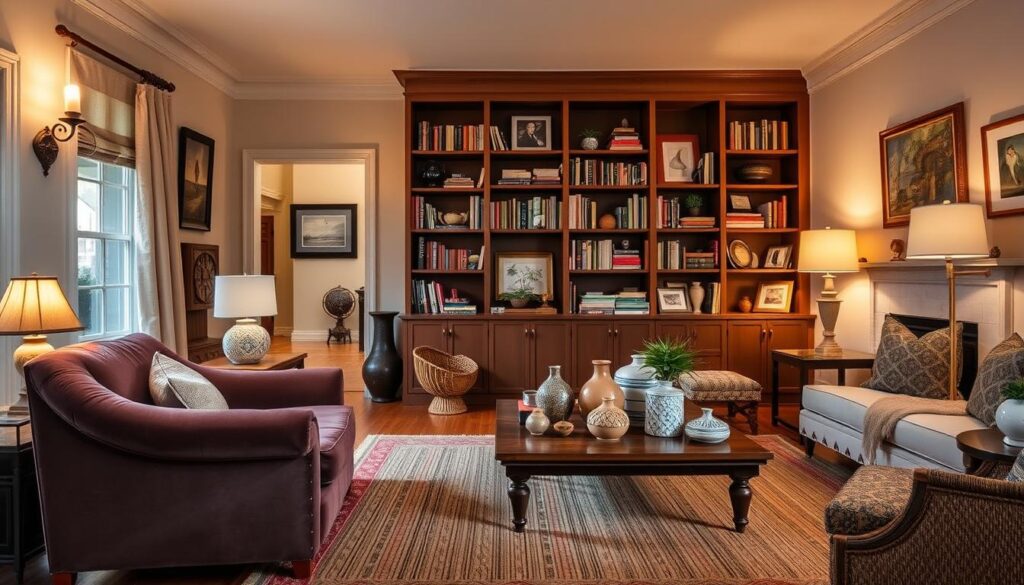
Minimalism with a Touch of Warmth
Minimalist design is changing, and it’s becoming more inviting. The newest trends mix simplicity with coziness. This creates a softer, more welcoming look.
Core Principles
Minimalist design is known for its clean lines and simple colors. To add warmth, we use textiles and decor. These elements bring comfort and personality to the space.
Adding Cozy Touches
To warm up minimalism, we use soft throw blankets, rugs, and pillows. These are made from natural materials like wool and cotton. Vintage pieces or artwork also add interest and coziness.
By blending minimalist design with warm touches, we make our homes calm and inviting. This shows the latest in interior design trends.

